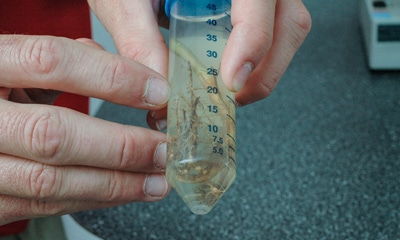
After harvest is a good time to test for soybean cyst nematode, Nebraska's "silent yield robber" for soybeans. Since first being confirmed in the state 30 years ago in Richardson County, SCN has now been confirmed in 58 counties, representing a majority of the soybean-producing counties in Nebraska.
This small plant-parasitic roundworm attacks soybean roots. The first obvious symptom is soybean yields that don't meet expectations. They may hit a plateau or even start to drop off, yet corn yields continue to increase when planted in the same field.

GOOD TIME TO TEST: After harvest, when life slows down a bit, it's a good time to test for SCN. John Wilson suggests testing in soybean stubble by pushing the soil probe into the ground alongside the stubble row at an angle toward the soybean root structure.
According to Nebraska Extension educator John Wilson, a more subtle indication that SCN may be present in a field is pockets of soybeans that show symptoms of sudden death syndrome or brown stem rot. Although these diseases show foliar symptoms in mid- to late summer, both of them enter the plant through the roots early in the growing season. Because SCN attacks the roots, it creates microscopic wounds, making it easier for either of the diseases to enter the plant, he explains.
Wilson says that it is a good idea to test fields for SCN after harvest when life is just a little slower. "You can see on your yield maps, or it is still fresh in your mind, where there were unexpectedly lower yields compared to other parts of the field," Wilson says. There are many possible reasons for such yield issues, but SCN would be one of the possibilities.

Wilson suggests testing in soybean stubble by pushing the soil probe into the ground alongside the stubble row at an angle toward the soybean root structure. "You are more likely to detect the presence of SCN near the root system," he says. Wilson also recommends taking samples inside areas in the field where yields were unexpectedly lower, and outside that area of the field where yields were higher.
"If you have high SCN populations inside the area of lower yields and lower populations where yields are higher, that probably means there is a problem with SCN," Wilson says.
"An excellent time to sample is when fields are sampled for next year's fertilizer program," Wilson suggests. "Take a few more soil cores, mix them together and send in half for fertility testing and the other half for a free SCN analysis. Often, your co-op, crop consultant or agronomist can collect these samples for you."
The Nebraska Soybean Board has partnered with Nebraska Extension to provide bags to submit soil samples for a free SCN analysis. You can pick up your sample bag at your local Extension office.
Learn more about SCN by contacting Wilson at 402-374-2929 or Nebraska Extension pathologist Loren Giesler at 402-472-2559.
About the Author(s)
You May Also Like






